My Account / Login


Year 3 – Place Value
Welcome to Year 3 Place Value at Primary Maths Hub. Here you will find a growing library of outstanding resources and activities to support place value lessons in Year 3 and at home.
If there’s a resource you’d like to see here, just visit our ‘Request a Resource’ page and Primary Maths Hub will create the resource and add it to the site.
Do Now Tasks / Starters

Place Value to 1,000 Do Now Tasks

10 More or Less Do Now Tasks

100 More or Less Do Now Tasks

Faded Scaffolding Strips- Count Forwards in Tens

Faded Scaffolding Strips- Count Backwards in Tens

Faded Scaffolding Strips- Count Forwards and Backwards in Tens

Faded Scaffolding Strips- Count Forwards in Tens and Hundreds

Faded Scaffolding Strips- Count Backwards in Ten and Hundred

Faded Scaffolding Strips- Count Forwards and Backwards in Tens and Hundreds

Place Value- Faded Scaffolding Strips- Count Forwards in Hundreds

Faded Scaffolding Strips- Count Backwards in Hundreds

Faded Scaffolding Strips- Count Forwards and Backwards in Hundreds
Read and write numbers.

Write Numbers to 1,000 in Digits

Write Numbers to 1,000 in Words

How to Write Numbers to 1000

Faded Scaffolding Strips- Place Value of Numbers to 1,000 Write in Digits

Faded Scaffolding Strips- Place Value of Numbers to 1,000 Write in Words
10 and 100 more, 10 and 100 less.

10 Less to 1000

10 More and 10 Less to 1000

10 More to 1000

100 Less to 1000

100 More and 100 Less to 1000

100 More to 1000

10 or 100 More or Less to 1,000

10 or 100 Less to 1,000

10 or 100 More to 1,000
Compare and order numbers.

Order Numbers to 1000

Compare Numbers to 1000

Faded Scaffolding Strips- Compare Numbers to 1,000

Faded Scaffolding Strips- Rounding 2-Digit Numbers to the Nearest 10

Faded Scaffolding Strips- Rounding 3-Digit Numbers to the Nearest 10
Expanded form and underlined digit.

Place Value of Numbers to 1000 – Expanded Form

Place Value of Numbers to 1000 – Expanded Form to Digits

Place Value of Numbers to 1000 – Value of the Underlined Digit

Faded Scaffolding Strips- Place Value of Numbers to 1,000 Expanded Form

Faded Scaffolding Strips- Place Value of Numbers to 1,000 Expanded Form to Digits

Faded Scaffolding Strips- Place Value of Numbers to 1,000 Value of Underlined Digit
Representation and number lines.

Represent Numbers to 1000 on a Number Line

Represent Number to 1000

Estimate Numbers to 1000 on a Number Line

Flexible Partitioning to 1000
Equality and inequality statements.

Equality and Inequality Statement Matching
Word problems and challenges.

Compare and Order Numbers to 1,000 – Challenges

Place Value of Numbers to 1,000 – Challenges
Resources to support place value.

Arrow Cards

Place Value Grid

Number Lines to 1000

Number Lines to 1000 (Portrait)

Use Place Value Chart
Steps to success.

Read and Write Numbers to 1,000- Steps to Success

Determine the Value of Digits in Numbers to 1,000- Steps to Success

Compare Numbers to 1,000- Steps to Success

Order Numbers to 1,000- Steps to Success
Can't find what you are looking for.
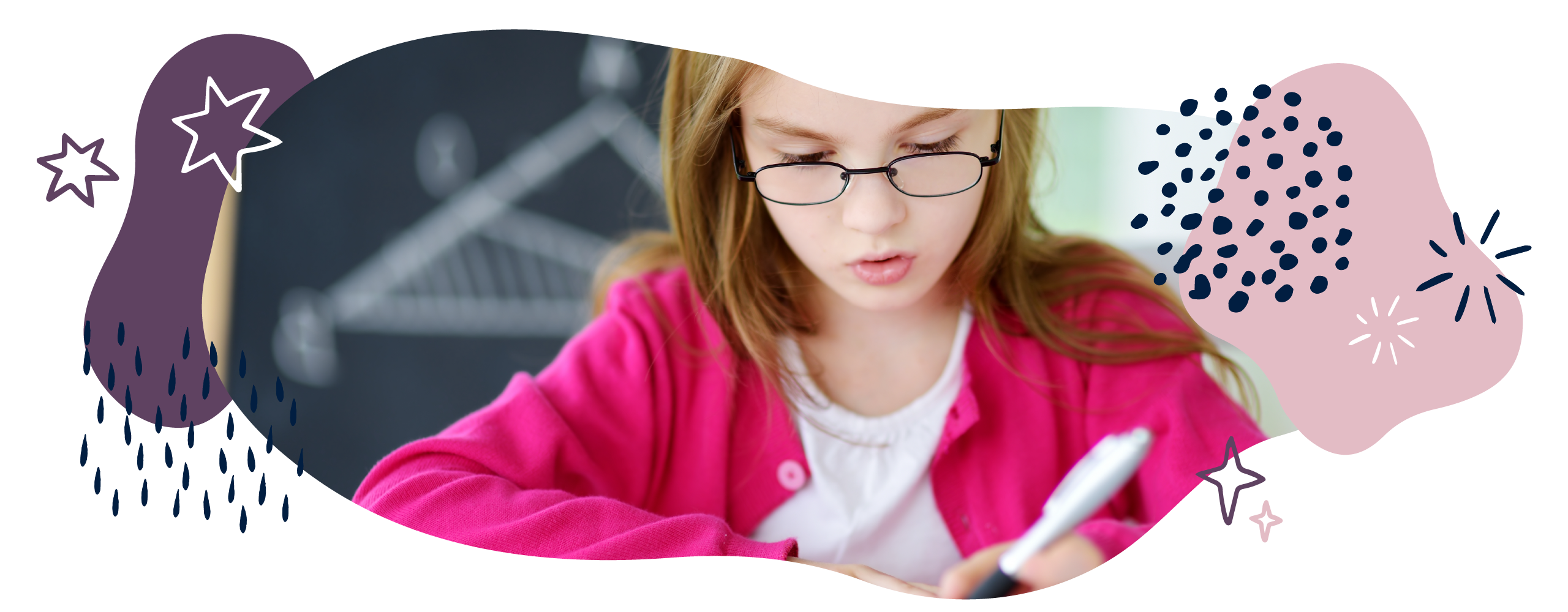
2. Compare and order numbers
When comparing numbers up to 1000, your child should look at the digit with the largest value first. For example, if your child is comparing the numbers 765 and 276, they would first need to look at the digit with the largest value, i.e. the hundreds digit:
276 has 2 hundreds, and 765 has 7 hundreds, so 276 is less than 765.
However, if we compare the numbers 765 and 754, they both have the same number of hundreds. Therefore, we now need to look at the tens digit:
765 has 6 tens, and 754 only has 5 tens, so 765 is more than 754.
Try this game to practise comparing numbers. Write twenty two- and three-digit numbers and the ‘>’ and ‘<’ symbols on separate pieces of paper. Deal your child two numbers, face down. Ask them to turn over the pieces of paper and to use the ‘>’ and ‘<’ symbols to show which number is bigger or smaller.
Activity: Number statements

3. Practise counting
Your child should now use the word multiples to describe counting up in steps from zero, securing their understanding of multiplication.
They will be expected to count in multiples of 2, 3, 4, 5, 8, 10, 50, and 100. You could help your child practise by taking it in turns to say the multiples of a number. For example:
You : 4 Your child : 8 You : 12 … and so on.
Set a timer and see what number you can get to before a minute is up! Be sure to note any interesting patterns, like how multiples of five always end in a 5 or a 0.
4. Learn multiplication facts
In Year 3, it’s important that your child is able to recall multiplication facts. They will be likely to focus on the 3, 4, and 8 times tables. They will already be familiar with the 2, 5, and 10 times tables, but they will still practise them.
Video: What are multiples?
- Age 3–4 (Early Years)
- Age 4–5 (Reception)
- Age 5–6 (Year 1)
- Age 6–7 (Year 2)
- Age 7–8 (Year 3)
- Age 8–9 (Year 4)
- Age 9–10 (Year 5)
- Age 10–11 (Year 6)
- Year 1 (age 5–6)
- Year 2 (age 6–7)
- Year 3 (age 7–8)
- Year 4 (age 8–9)
- Year 5 (age 9–10)
- Year 6 (age 10–11)
- Help with times tables
- Ratio & proportion
- Learning to tell the time
- Numicon parent guide
- MyMaths parent guide
- Maths activity books
Planning tool
Year levels.
- {{PlanningToolMenuItem.Name}}
Expected level of development
Australian Curriculum Mathematics V9 : AC9M3N03
Numeracy Progression : Additive strategies: P8, Number and place value: P5
At this level, students consolidate and deepen place value knowledge of two- and three-digit numbers. They do this by partitioning, rearranging and regrouping numbers to help in addition and subtraction calculations.
Use physical and virtual materials and visual representations to explore the proportional nature of place value parts when solving addition and subtraction problems. Provide repeated opportunities for students to explore different ways of partitioning, rearranging and regrouping when making calculations. For example: they explain that 163 + 28 can be more easily solved by breaking the numbers into place value parts, that 160 + 20 = 180 and 3 + 8 = 11, which then becomes 180 + 11 which makes 191.
Pose addition and subtraction problems horizontally (rather than vertically) to encourage students to think about problems in terms of place value parts. Ensure that students know they can rewrite and think about addition and subtraction problems horizontally, even if they are presented vertically to begin with. Use regular number talks to develop mental computation strategies. Include a focus on applying addition and subtraction strategies in a range of contexts, including through story problems.
Ensure students understand that different strategies will be more efficient at different times, for different people and across different problems.
Encourage students to value depth over speed. Celebrate sense-making, reasoning and lessons learned from mistakes when exploring and sharing strategies.
Teaching and learning summary:
- Use classroom talks and play-based explorations, in conjunction with explicit teaching, to support key understandings.
- Encourage reasoning, and emphasise the similarities and differences between different computation strategies used.
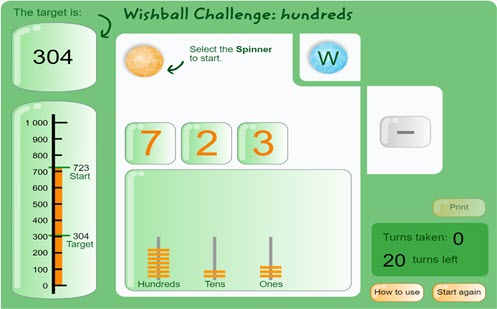
- justify choices when partitioning and regrouping numbers to perform addition and subtraction
- mentally solve addition and subtraction problems using partitioning, rearranging and regrouping, and explain the strategy used
- use written recordings to clearly display the solution used
- apply strategies involving partitioning, rearranging and regrouping when solving worded problems.
Some students may:
- be able to identify place value parts and count orally to 100 and beyond but still think about two- and/or three-digit collections additively in terms of ones (for example, understand 468 as the sum of 400 ones, 60 ones and 8 ones). To address this, consolidate place value understanding by comparing and ordering two-digit numbers (for example, which is larger – 2 bundles of ten and 3 ones, or the number 41 shown on a number line), counting forward and backward by tens and ones, and by renaming (for example, 32 is 3 tens and 2 ones; it’s also 32 ones; and it can also be 2 tens and 12 ones).
- consider each digit in an addition problem as a separate number as opposed to representing a place value part. When using the vertical or column method, failing to recognise the place value of the digits leads to a lack of reasoning and precision. To address this, present addition problems horizontally and create habits of reasoning that draw on place value understanding through number talks and other activities that focus on mental computation and breaking numbers up into their place value parts.
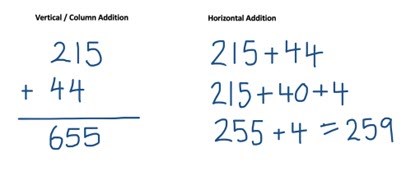
- subtract the smaller digit, regardless of which appears first when using the vertical or column method, indicating a lack of reasoning and understanding of the operation being used. To address this, present subtraction problems horizontally and create habits of reasoning through number talks and other activities that invite mental computation strategies and involve thinking in terms of place value parts.
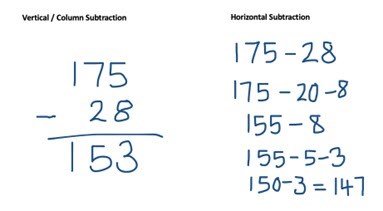
The Learning from home activities are designed to be used flexibly by teachers, parents and carers, as well as the students themselves. They can be used in a number of ways including to consolidate and extend learning done at school or for home schooling.
Learning intention
- We are learning how place value parts help solve addition and subtraction problems.

Why are we learning about this?
- We use addition and subtraction in everyday contexts.
Use two- and three-digit numbers every day.
- Go on a number hunt. Look for, recognise and read the numbers around you, for example, numbers you notice around you on signs, calendars, speed signs and houses.
- Use everyday opportunities to practise using mental addition and subtraction strategies, such as predicting the change you will get at the store.
- Play ‘Guess my number’ or other games to put place value understanding into practice. Player 1 writes a two- or three-digit number on a piece of paper and the Player 2 asks ‘yes/no’ questions about it until they guess it. Example questions could be, ‘Is it larger than 500? Does it have an odd number in the hundreds place?’.
See mistakes as opportunities
- Know that mistakes are normal whenever we are learning or growing.
- When you get an incorrect answer, take the time to be curious about the mistake and see if you can learn from it. Which part of your strategy doesn’t quite make sense? How else could you approach the same problem?
Success criteria
- use the relationship between addition and subtraction to make some calculations
- solve addition problems mentally and verbally (for example, without pencil and paper) using place value parts
- solve subtraction problems mentally and verbally (without pencil and paper) using place value parts.
Please note: This site contains links to websites not controlled by the Australian Government or ESA. More information here .
Go to section
Teaching strategies.
A collection of evidence-based teaching strategies applicable to this topic. Note we have not included an exhaustive list and acknowledge that some strategies such as differentiation apply to all topics. The selected teaching strategies are suggested as particularly relevant, however you may decide to include other strategies as well.
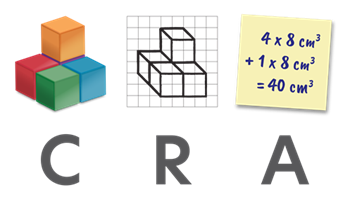
Concrete, Representational, Abstract (CRA model)
The CRA model is a three-phased approach where students move from concrete or virtual manipulatives, to making visual representations and on to using symbolic notation.
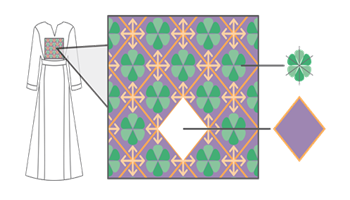
Culturally responsive pedagogy
Mathematics is not an exclusive western construct. Therefore, it is important to acknowledge and demonstrate the mathematics to be found in all cultures.

Collaborative learning
For group work to be effective students need to be taught explicitly how to work together in different settings, such as pairs or larger groups, and they need to practise these skills.
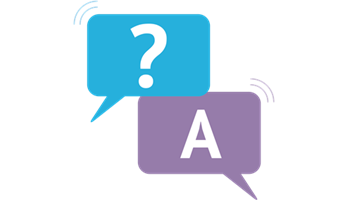
Questioning
A culture of questioning should be encouraged and students should be comfortable to ask for clarification when they do not understand.
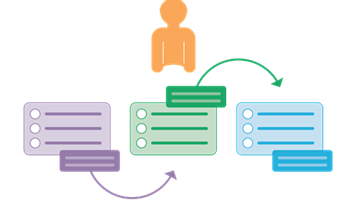
Multiple exposures
Providing students with multiple opportunities within different contexts to practise skills and apply concepts allows them to consolidate and deepen their understanding.
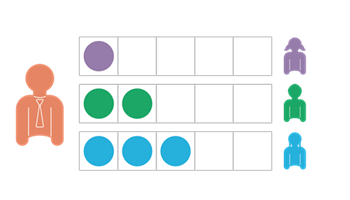
Classroom talks
Classroom talks enable students to develop language, build mathematical thinking skills and create mathematical meaning through collaborative conversations.
Teaching resources
A range of resources to support you to build your student's understanding of these concepts, their skills and procedures. The resources incorporate a variety of teaching strategies.
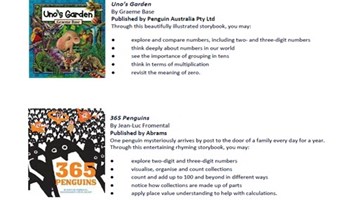
Picture Storybooks: Year 3 place value
Use picture storybooks regularly to spark curiosity and interest in place value and related concepts.
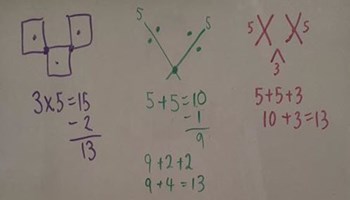
Classroom Talks: Year 3 – Place Value
Run 5- to 15-minute classroom talks regularly to consolidate and build upon the foundations of place value.
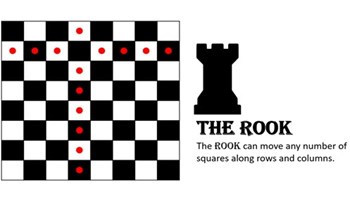
resolve: Addition: Chess – The Rook
Explore addition using place value parts using the concept of chess.
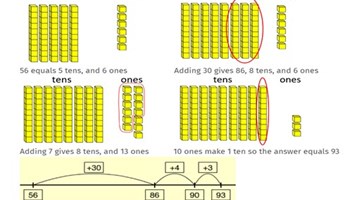
Addition and subtraction with whole numbers
Use this unit to explore situations involving addition and subtraction where students choose strategies, using place value understanding.
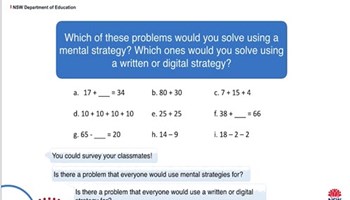
Which would you do in your head?
Encourage students to think about which strategies suit them best when solving different addition and subtraction problems.
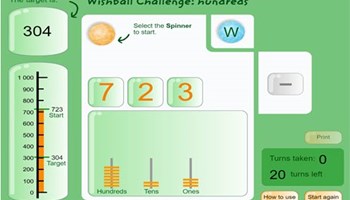
Wishball challenge: hundreds
Encourage students to think about the best strategies to use when solving different addition and subtraction problems.
Composition and calculation: 1,000 and four-digit numbers
Explore the composition of 1,000 and four-digit numbers.
Relevant assessment tasks and advice related to this topic.
By the end of Year 3, students extend and use single-digit addition and related subtraction facts and apply additive strategies to model and solve problems involving two- and three-digit numbers.
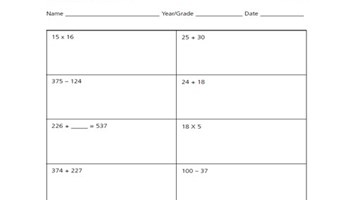
Assessment: Find the Solutions
Use the problems involving addition and subtraction to assess key understandings.
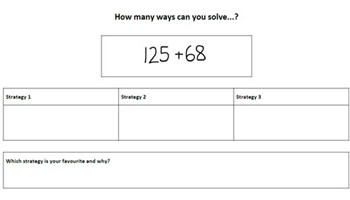
How many ways can you solve?
Use this task to gauge how students generate and reflect on strategies based on place value when solving problems.

Cooper Perry Primary
Aim high, believe in yourself and celebrate success together..
- On Fire - Place Value Reasoning and Problem Solving
- Class Pages
- Home Learning
- DU-Spotting-Patterns-Number-Generator.pdf
- DU-YR3-ConvinceMe-Place-Value.pdf
Wednesday and Thursday
- Year-3-Place-Value-Block-1-Consolidation-Reasoning-and-Problem-Solving.pdf
- The problem - you can print this problem to complete it or you can do it electronically.
- If you need a tip to help you get started, click on this link!
Unfortunately not the ones with chocolate chips.
Our cookies ensure you get the best experience on our website.
Please make your choice!
Some cookies are necessary in order to make this website function correctly. These are set by default and whilst you can block or delete them by changing your browser settings, some functionality such as being able to log in to the website will not work if you do this. The necessary cookies set on this website are as follows:
Website CMS
A 'sessionid' token is required for logging in to the website and a 'crfstoken' token is used to prevent cross site request forgery. An 'alertDismissed' token is used to prevent certain alerts from re-appearing if they have been dismissed. An 'awsUploads' object is used to facilitate file uploads.
We use Matomo cookies to improve the website performance by capturing information such as browser and device types. The data from this cookie is anonymised.
Cookies are used to help distinguish between humans and bots on contact forms on this website.
Cookie notice
A cookie is used to store your cookie preferences for this website.
- International
- Education Jobs
- Schools directory
- Resources Education Jobs Schools directory News Search

Place Value Problem Solving Year 3
Subject: Mathematics
Age range: 7-11
Resource type: Worksheet/Activity
Last updated
1 October 2016
- Share through email
- Share through twitter
- Share through linkedin
- Share through facebook
- Share through pinterest

Creative Commons "Attribution"
Your rating is required to reflect your happiness.
It's good to leave some feedback.
Something went wrong, please try again later.
annierosalind
Empty reply does not make any sense for the end user
Report this resource to let us know if it violates our terms and conditions. Our customer service team will review your report and will be in touch.
Not quite what you were looking for? Search by keyword to find the right resource:

Problem Solving with Place Value
February 3, 2021.
Understanding place value provides the essential foundation for so many aspects of mathematics, from multiplying and dividing by powers of ten, understanding the equivalence between fractions, decimals and percentages, and learning how to write and calculate with numbers in standard form.
The videos below show how I use the place value table to teach these topics conceptually.
Writing numbers as words
Multiplying by 10, 100 and 1000
Converting between fractions, decimals and percentages
I designed this problem-solving lesson to deepen students’ understanding of place value to connect it to other aspects of mathematics, including listing permutations, odd and even numbers and money. By linking to these topics, the questions are challenging yet remain accessible to students in key stage 3 and those studying the foundation GCSE course.
The lesson consists of six problem-solving questions, all centred around place value. Here is a sample of three of the questions.
Here is a sample of three of the questions.
Linking place value to arithmetic

In this question, students link their understanding of place value to writing numbers in figures from words. Next, they use column subtraction to find the difference between two numbers.
Linking place value to permutations

In this question, students arrange the four single-digit cards to make the numbers between 230 and 430.
Students link their understanding of place value to listing permutations.
Linking place value to odd and even numbers

To work out the smallest, even number, students need to find two three-digit numbers with the least difference.
To calculate the biggest, odd number, they need to find two numbers with the greatest difference.
Both questions can be completed through a method of trial and improvement. More able students would use:
- odd + odd = even
- odd + even =odd
- even + odd = odd
- even + even = even.
Teach this lesson
Share this article….
[Sassy_Social_Share]
About Mr Mathematics

My name is Jonathan Robinson and I am passionate about teaching mathematics. I am currently Head of Maths in the South East of England and have been teaching for over 15 years. I am proud to have helped teachers all over the world to continue to engage and inspire their students with my lessons.
If you liked this you may like …
Importance of place value in mathematics.
How to teach place value conceptually.
Mr Mathematics Blog
Getting ready for a new school year.
How to prepare your mathematics department ready for September.
Flipped Classroom Strategies for Maths Teachers
Discover effective strategies for flipping the math classroom to enhance student engagement and outcomes for KS3, GCSE/IGCSE and A-Level Mathematic
Estimating Solutions by Rounding to a Significant Figure
Explore key concepts, FAQs, and applications of estimating solutions for Key Stage 3, GCSE and IGCSE mathematics.

- Home Learning
- Free Resources
- New Resources
- Free resources
- New resources
- Filter resources
- Childrens mental health
- Easter resources
Internet Explorer is out of date!
For greater security and performance, please consider updating to one of the following free browsers
Place Value Consolidation Year 3 Autumn Block 1 Reasoning and Problem Solving
Place value consolidation year 3 autumn block 1 questions.
This Place Value Consolidation Year 3 Autumn Block 1 resource is aimed at Year 3 Secure and has been designed to give children the opportunity to consolidate the skills they have learned in Block 1 – Place Value.

Not a member? Sign up here.
What's included in the pack?
This pack includes:
- Place Value Consolidation Year 3 Autumn Block 1 Reasoning and Problem Solving worksheets (includes answers).
National Curriculum Objectives
Mathematics Year 3: Identify, represent and estimate numbers using different representations
Mathematics Year 3: Count from 0 in multiples of 4, 8, 50 and 100; find 10 or 100 more or less than a given number
Mathematics Year 3: Compare and order numbers up to 1000
Mathematics Year 3: Read and write numbers up to 1000 in numerals and in words
Mathematics Year 3: Recognise the place value of each digit in a three-digit number (hundreds, tens, ones)
Mathematics Year 3: Solve number problems and practical problems involving these ideas
Small Steps:
Represent numbers to 1,000
100s, 10s, 1s (1)
Number line to 1,000
Find 1, 10, 100 more or less than a given number
Order numbers
Count in 50s
This resource is available to download with a Premium subscription.
Our Mission
To help our customers achieve a life/work balance and understand their differing needs by providing resources of outstanding quality and choice alongside excellent customer support..
Yes, I want that!
Keep up to date by liking our Facebook page:
Membership login, stay in touch.
01422 419608
[email protected]
Interested in getting weekly updates from us? Then sign up to our newsletter here!
| Thank you for Signing Up |

Information

- Cookie Policy
- Privacy Policy
- Terms and Conditions
Copyright: Classroom Secrets 2024
Company number: 8401067
VAT number: 248 8245 74
- Terms & Conditions
Designed by Classroom Secrets
Maintenance underway!
We're currently carrying out some planned maintenance, which might mean some disruption. We're working hard to minimise any disruption and bring some exciting changes. Thanks for your understanding.
Reasoning/Problem Solving Maths Worksheets for Year 3 (age 7-8)
Money problems and challenges.
A variety of problem solving activities involving money.

50p to spend, but can you make sure you get the correct change?

Watch out when writing pence as pounds and remember to always have two digits after the decimal point.
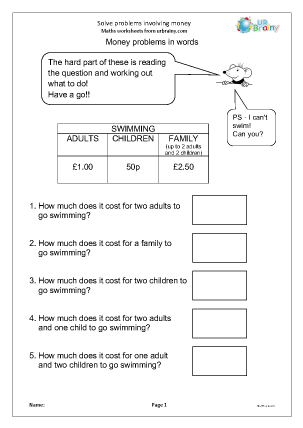
The hardest part of these money problems is to read the question and work out what to do.
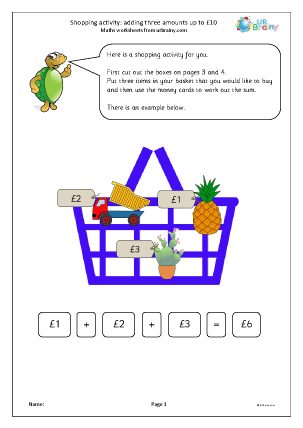
Put three items in your basket that you would like to buy and then use the money cards to work out the sum.
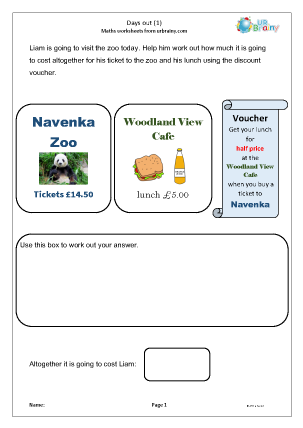
Solve money problems using the information provided.
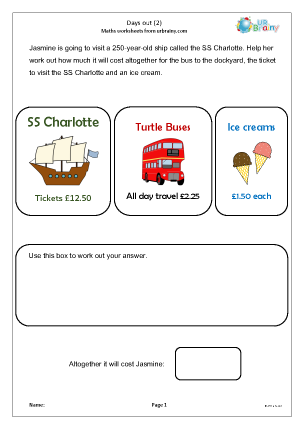
Solve money problems at the skating rink.

Plenty of monkey business here!

It's a trip to the zoo to find the very best value.
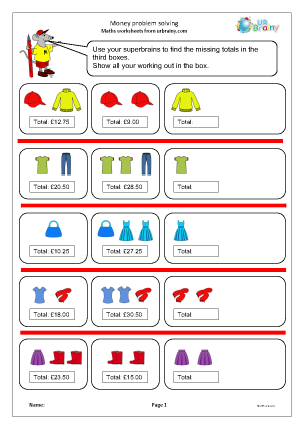
Some tricky money problems to solve.
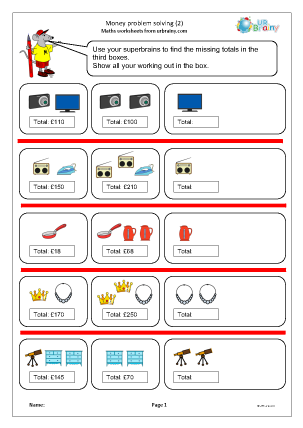
More tricky money problems to solve.

Finding different amounts from a given set of coins.
Number and calculating problems
Solve number problems and calculating using addition, subtraction, multiplication and division.

Find the 2-digit numbers that can be made using these digit cards.
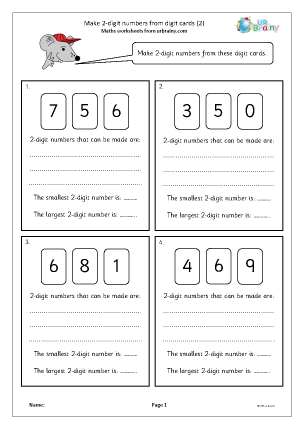
Make 2-digit numbers and find the smallest and largest numbers.

More on finding 2-digit numbers from three digit cards.

Tricky little problems involving monsters' legs.
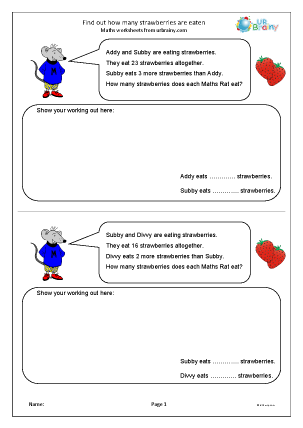
Use logic, addition and subtraction to find out how many strawberries are eaten.

Bar Model: addition and subtraction facts.

Use bar models to add and subtract.

Encourage children to make addition and subtraction come to life by writing short number stories.

What numbers can you make with digit cards?

What are the largest and smallest numbers that can be made with 3 cards?
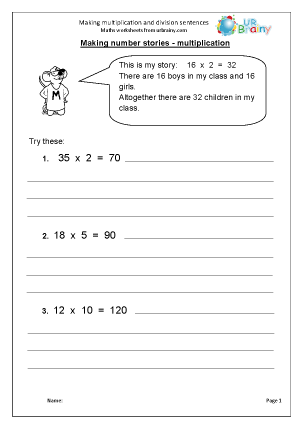
More number stories to write: this time all about multiplication and division.

All the numbers are here, but the signs are missing! Can you work out what the signs should be?

Investigating odd and even numbers and what happens when you add them together.

Use knowledge of place value to find all possible answers.

Finding the numbers and missing digits to make number sentences correct.

Investigate statements involving odd and even numbers.
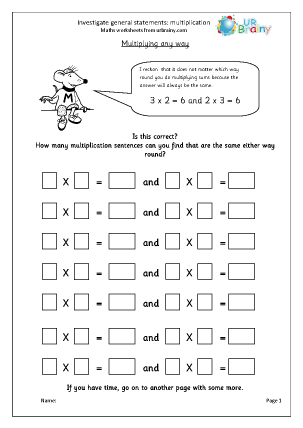
Investigate statements about multiplication and times tables.
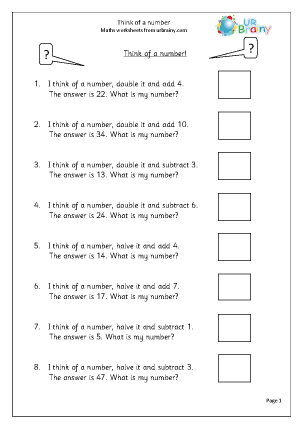
I?m good at thinking of numbers, but can you work out what number I am thinking about ? I do give a clue!

Work out the missing value using division and addition.

Use reasoning to find the missing values.

More on finding the missing values - an early introduction to algebra.
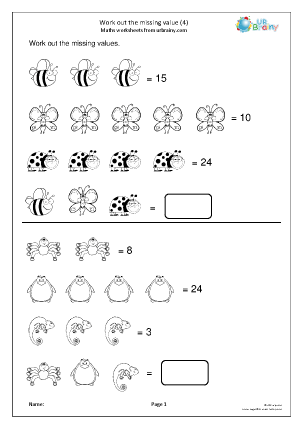
Use division and addition to find the missing values.

Find the missing values from the information given.

More on finding the value using reasoning.
Real life and word problems
A selection of real life problems and word problems.

Tricky word problems.

More tricky word problems.
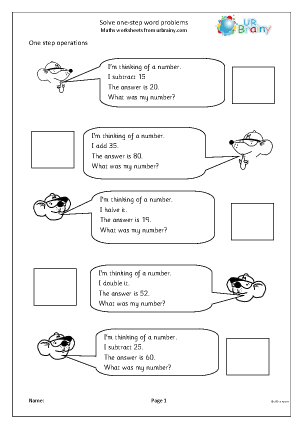
Tricky questions, but you only have to carry out one maths step to answer them.

Even trickier questions, and you have to carry out at least two steps to work them out!

More word problems, from the library to shopping and on to flying around the world.
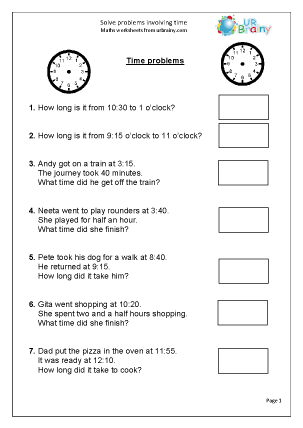
Here we have four pages of questions all on time, including a trip to Alicante!
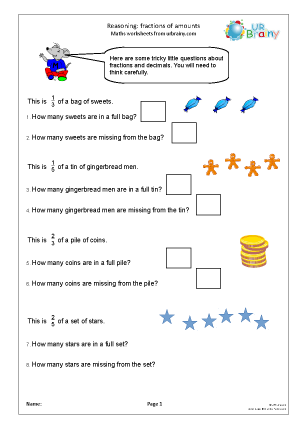
Solving tricky fraction problems.
More challenges and activities
A great selection of activities requiring logical thinking.
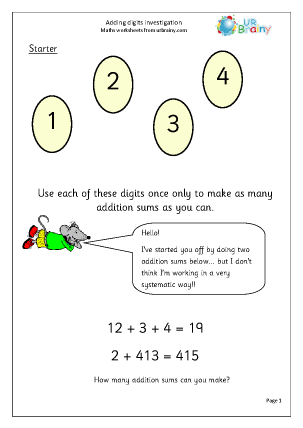
Investigation looking at possibilities when adding the digits from 1 to 5.
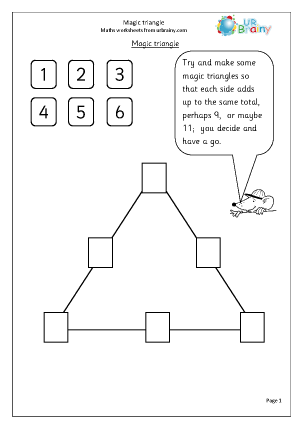
This time you can decide the total for the sides of the triangle.
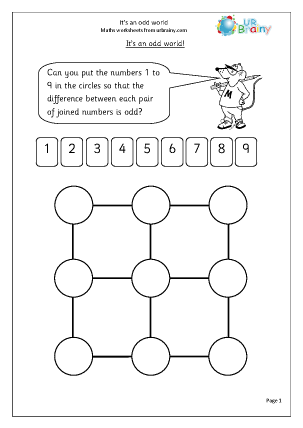
Can you put the numbers 1 to 9 in the diagram so that the difference between each pair of joined numbers is odd?

This challenge is to find as many ways as possible of making 12 using three number cards and the add, subtract and multiply signs.

A development of the 'Caterpillar investigation' but using multiples of 10. Great for practising addition.

3 dinosaurs laid some eggs. They laid 19 altogether. How many did they each lay?

How many ways can three runners cover a distance of 19 miles? They all have to run an odd number of miles.

A book challenge here. How accurately can you guess the number of pages in books?
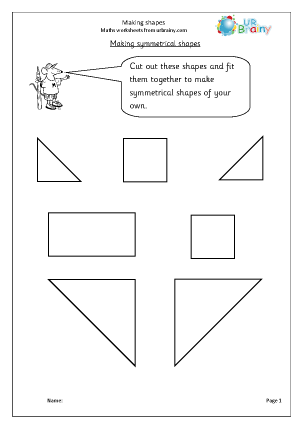
2D card shapes and a 3 x 3 pinboard are useful for these shape activities.

A calculator is needed to find how many different answers can be made from the numbers given. Good for working in an organised, logical way.
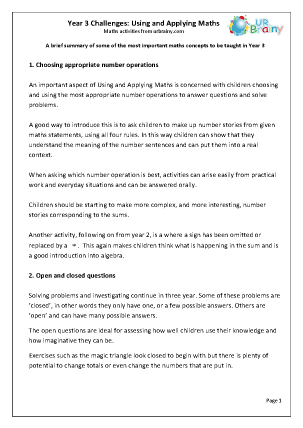
A brief summary of some of the most important maths concepts to be taught in Year 3 by way of challenges and investigations.
Subscribe to our newsletter
The latest news, articles, and resources, sent to your inbox weekly.
© Copyright 2011 - 2024 Route One Network Ltd. - URBrainy.com 11.1.7
You'll need JavaScript enabled to experience the full functionality of this site. Please enable JavaScript by following the instructions at enable-javascript.com .
Sorry, the browser you're currently using is not supported by this site. Please upgrade your browser by following the instructions at browser-update.org .

Place Value Word Problems (Year 3)
Write a review

Choose your format:
Save to Your Lessons
Save to Homework
Share resource
Your download limit has been reached!
Check out our FAQs for more info.
In this resource, children are encouraged to solve a variety of place value word problems, based on school locker codes, drink prices and the heights of different animals.
Answers are provided.
- Key Stage: Key Stage 2
- Subject: Maths
- Topic: Addition & Subtraction
- Topic Group: Calculations
- Year(s): Year 3
- Media Type: PDF
- Resource Type: Worksheet
- Last Updated: 24/10/2023
- Resource Code: M2WAE110
- Curriculum Point(s): Solve problems, including missing number problems, using number facts, place value, and more complex addition and subtraction.
Related Topics:
Other Teachers Downloaded...

Addition Problems — 3-Digit Numbers (Year 3)
- Addition & Subtraction
- Key Stage 2 Maths

Addition and Subtraction — Missing Numbers (Year 3)

Times Tables Word Problems — 3, 4 and 8 (Year 3)
- Multiplication & Division

The Broken Vase — Inference Scaffolding (Years 3-4)
- Comprehension
- Key Stage 2 English

Code Breakers – Addition (Year 3)

Word Problems — Subtraction (Year 3)
No reviews (yet!)
Related Resources

Place Value Problems — 3-Digit Numbers (Year 3)

Adding and Subtracting Mentally (Year 3)

Place Value (Year 4)
- Place Value

Place Value Crossword (Year 4)
- Solving Problems

Formal Addition — Column Method (Year 3)

Number and Place Value — Colour by Numbers (Year 3)

Adding and Subtracting Numbers with Three Decimal Places (Year 5)

Number and Place Value — Arcade Trip Word Problems (Year 3)

Formal Subtraction — Column Method (Year 3)

Place Value — Cake Shop Problems (Year 2)
- Key Stage 1 Maths

Adding 4-Digit Numbers (Year 4)

Compare and Order Numbers up to 1000 (Year 3)
Cookies are disabled on your browser. This means some features of the site won't be fully available to you.
CGP uses cookies to give you a smooth shopping experience and to help us understand how well our site is working. To agree to us using all cookies, click 'Accept', or to reject optional cookies click 'Customise'.
Accept cookies Customise cookies

IMAGES
COMMENTS
A set of three differentiated worksheets that work on place value for Year 3 children. Having used a similar format in my own lessons, these sheets often provide eno ... reasoning and problem solving (HA) Answers are included for each sheet. Creative Commons "Sharealike" Get this resource as part of a bundle and save up to 87%. A bundle is a ...
Or, you could try this Year 3 Solve Number and Practical Problems PowerPoint! Using these place value problem-solving worksheets in lessons. Problem-solving worksheets are great for independent learning and developing children's understanding of various topics, including place value.
Challenge your year 3 pupils with these fantastic challenge cards which provide a range of maths mastery activities based around the year 3 objective, to 'recognise the place value of each digit in a three-digit number (hundreds, tens, ones)'. These could be used as part of a lesson, as a group task or they could even be displayed as part of your interactive maths display. How about ...
Welcome to Year 3 Place Value at Primary Maths Hub. Here you will find a growing library of outstanding resources and activities to support place value lessons in Year 3 and at home. If there's a resource you'd like to see here, just visit our 'Request a Resource' page and Primary Maths Hub will create.
Number & place value in Year 3 (age 7-8) In Year 3, your child will start to work with bigger numbers, all the way up to 1000. They will count in multiples of 4, 8, 50, and 100, and will use their understanding of place value to solve increasingly tricky number problems. The key words for this section are number and place value.
Using these year 3 place value word problems in the classroom. Our year 3 place value word problems are great for independent learning and developing children's understanding of various topics, including place value! They download as a handy PDF, so you can print them off as many times as you need to. There are three different levelled ...
Use this set of 8 challenge cards to reinforce your teaching on year 3 number and place value maths mastery and test your students' knowledge. Great as an opening or finishing activity. ... 6 Maths Mastery - Fluency, Reasoning and Problem Solving Year 3. 2014 National Curriculum Resources Maths Key Stage 2 - Year 3, 4, 5, ...
JPG, 122.43 KB. Place Value - Year 3. In this teaching resource, pupils are taught about place value and how to recognise the place value of each digit in a three-digit number (hundreds, tens and ones). It is an ideal teaching aid to use in a lesson covering the year 3 curriculum objectives in the maths programme of study (Number - number and ...
Differentiated maths resources for Autumn Block 1 (Place Value) in small steps for KS2 children in Year 3. Each small step contains a range of resources including a teaching PowerPoint, varied fluency worksheets, reasoning and problem solving worksheets, homework or extension worksheets, discussion problems for collaborative learning, interactive games and a learning video clip.
Reasoning and Problem Solving -Place Value Consolidation -Year 3 1. Solve the clues and cross off the correct bricks! Princess Ota has done the first one to help! 2. Which view matches the letter? View 5. 3. Look at the number for each lock. Mark that number with a circle in the correct place on each of the three number lines.
Mathematics Year 3: (3N3) Recognise the place value of each digit in a three-digit number (hundreds, tens, ones) Mathematics Year 3: (3N6) Solve number problems and practical problems involving 3N1 - 3N4 Differentiation: Questions 1, 4 and 7 (Reasoning) Developing Using knowledge of place value, explain the odd one out by matching two
Or, you could try this Year 3 Solve Number and Practical Problems PowerPoint! Using these place value problem-solving worksheets in lessons. Problem-solving worksheets are great for independent learning and developing children's understanding of various topics, including place value!
Use physical and virtual materials and visual representations to explore the proportional nature of place value parts when solving addition and subtraction problems. Provide repeated opportunities for students to explore different ways of partitioning, rearranging and regrouping when making calculations. For example: they explain that 163 + 28 ...
Year-3-Place-Value-Block-1-Consolidation-Reasoning-and-Problem-Solving.pdf Friday The problem - you can print this problem to complete it or you can do it electronically.
Place Value Problem Solving Year 3. Subject: Mathematics. Age range: 7-11. Resource type: Worksheet/Activity. Quinterito's Shop. 4.27 227 reviews. Last updated. 1 October 2016. ... (Company No 02017289) with its registered office at Building 3, St Paul's Place, Norfolk Street, Sheffield, S1 2JE ...
read, write, order and compare numbers up to 10 000 000 and determine the value of. each digit (appears also in Reading and Writing Numbers) use the language of: equal to, more than, less than (fewer), most, least. compare and order numbers from 0 up to 100; use <, > and = signs. compare and order numbers up to 1 000.
Problem Solving with Place Value. I designed this problem-solving lesson to deepen students’ understanding of place value to connect it to other aspects of mathematics, including listing permutations, odd and even numbers and money. By linking to these topics, the questions are challenging yet remain accessible to students in key stage 3 ...
Place Value Consolidation Year 3 Autumn Block 1 Reasoning and Problem Solving worksheets (includes answers). National Curriculum Objectives. Mathematics Year 3: Identify, represent and estimate numbers using different representations. Mathematics Year 3: Count from 0 in multiples of 4, 8, 50 and 100; find 10 or 100 more or less than a given ...
Reasoning and Problem Solving Step 9: Ordering Numbers National Curriculum Objectives: Mathematics Year 3: (3N2a) Compare and order numbers up to 1000 Mathematics Year 3: (3N3) Recognise the place value of each digit in a three-digit number (hundreds, tens, ones) Mathematics Year 3: (3N4) Identify, represent and estimate numbers using different
Number and Place Value Primary Resources. Year 3 Diving into Mastery: Step 1 Represent Numbers to 100 Teaching Pack. 5.0 (3 reviews) Year 3 Diving into Mastery: Step 4 Hundreds Teaching Pack. 4.8 (4 reviews) Year 3 Diving into Mastery: Step 5 Represent Numbers to 1000 Teaching Pack. 5.0 (3 reviews)
Number and Place Value Addition Subtraction Multiplication Division Money Four Operations Fractions Geometry (Shape) Measuring and Time Statistics (Handling Data) Reasoning/Problem Solving Mental Arithmetic Year 3 Assessment New Weekly Programme Money: Australian $ Money: New Zealand $ Money: Euros
In this resource, children are encouraged to solve a variety of place value word problems, based on school locker codes, drink prices and the heights of different animals. Answers are provided. Curriculum Point (s): Solve problems, including missing number problems, using number facts, place value, and more complex addition and subtraction.
Use this set of 20 challenge cards with accompanying answers to reinforce your teaching on number and place value and test your students' knowledge. Great as an opening or finishing activity. Show more. place value year 3 year 3 place value challenge cards place value challenge cards year 3 year 3 place value place value challenge year 3 maths ...